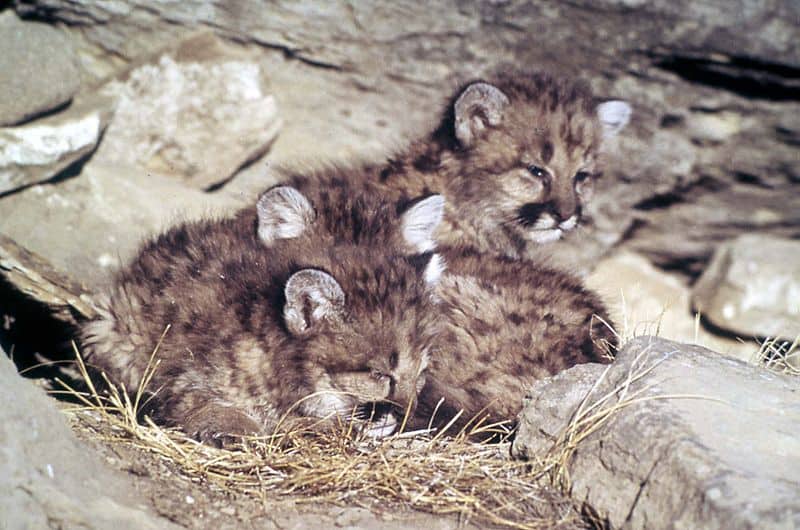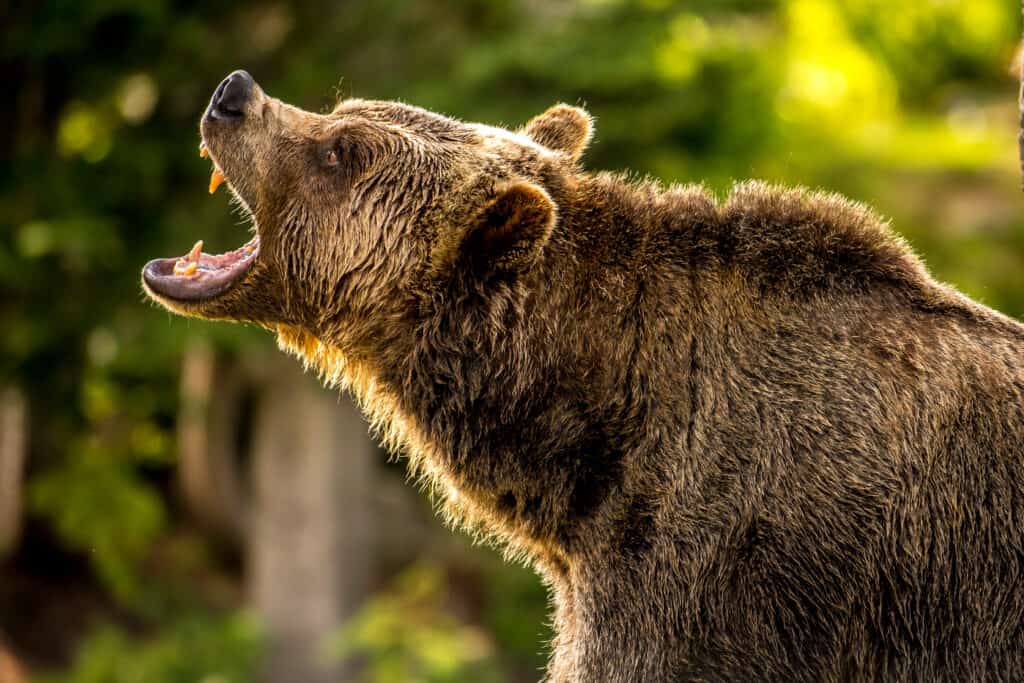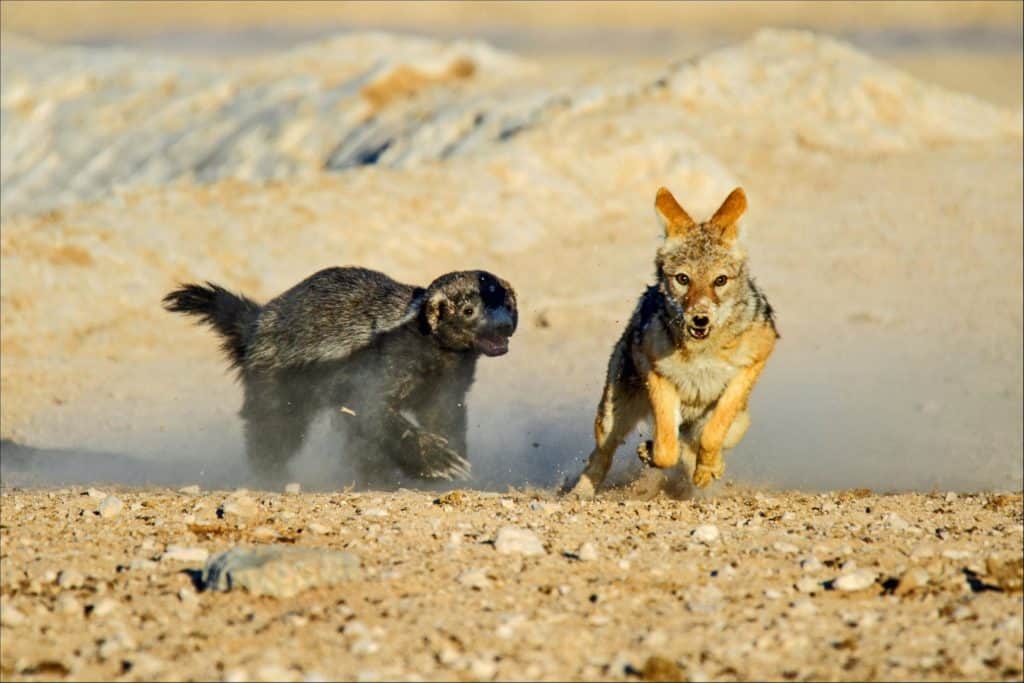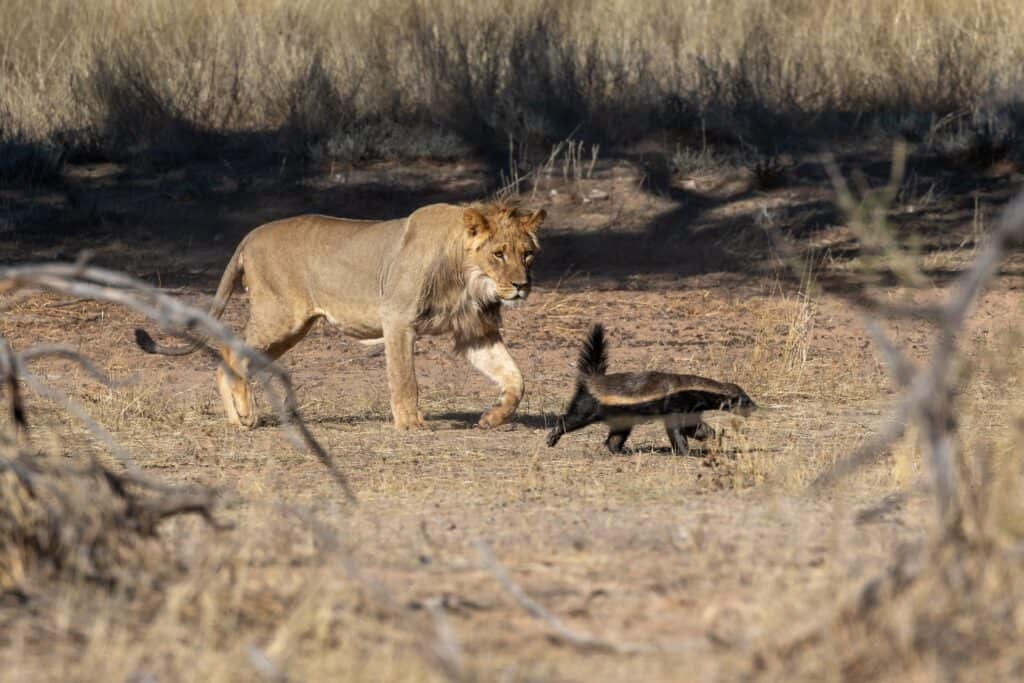Introduction
Honey badgers and mountain lions do not live in the same region. In fact, both animals reside in different hemispheres. While mountain lions are found in the Western Hemisphere in countries like the United States and Argentina, honey badgers can be encountered in Africa or southern Asia. Therefore, it’s unlikely that either animal would meet one another, let alone engage in a fight. However, if the chance for an epic battle between the two predators arose, only one could emerge victorious. Discover whether a honey badger or mountain lion would win in a fight and find out how both animals capture their prey.

Can the majestic mountain lion face off against the aggressive honey badger? Learn more about how these animals defend themselves.
©Warren Metcalf/Shutterstock.com
Background on Mountain Lions
Did you know that mountain lions are one of only two big cats native to the Western Hemisphere? Mountain lions, alongside jaguars, are found in the Western Hemisphere in various countries and continents. The mountain lion’s range is quite expansive, stretching from southern Argentina to southeastern Alaska. One interesting fact about the mountain lion’s distribution is that it is the largest of any other mammal in the Western Hemisphere.
In addition, mountain lions may also be called cougars, panthers, or pumas. The habitat of the mountain lion includes swamps, desert scrub, forests, and more, as the range of the mountain lion remains vast. While mountain lions can adapt to almost any climate or habitat, they tend to avoid areas with little vegetation. Therefore, these cats are unlikely to be encountered in expansive plains, where vegetation and shade are scarce.
Mountain Lion Appearance
The coloration of mountain lions appears tan or brown in most cases, but it may also appear reddish brown, gray, or black. Mountain lions with black fur are extremely rare, and few reports have indicated their existence. Furthermore, mountain lions usually display certain markings or designs on their faces, and the tail of the mountain lion features a black tip at the end.
In addition, mountain lions typically measure between 3.25 and 5.25 feet long. Their tail, though, adds greater length, measuring up to 33.5 inches long. Furthermore, mountain lions usually attain a similar size and weight as those of the jaguar, which is the only other big cat in the Western Hemisphere.
Moreover, mountain lions may differ in size according to their classification and location. Around six mountain lion subspecies exist, and their distribution may determine their appearance. For instance, mountain lions that live near the Equator appear smaller than mountain lions farther from the Equator.
In North America, most mountain lions weigh 136 pounds on average. However, some mountain lions have recorded weights of up to 220 pounds. In addition, male and female mountain lions record different lengths and weights. For example, female mountain lions record an average weight of 93 pounds, which measures 43 pounds lighter than the average weight of their male counterparts.

Mountain lion cubs may show distinct dark spots on their fur, and these spots fade as they mature.
©WL Miller, Public domain, via Wikimedia Commons – License
How Does a Mountain Lion Capture its Prey?
Mountain lions are predators and hunters with incredible skills that aid them in catching prey. Examples of prey of the mountain lion include deer, rabbits, turkeys, raccoons, elk, and more. For one, mountain lions can easily sneak up on their prey before attacking. They conceal themselves well in vegetation and camouflage into their surroundings while stalking prey. By the time the prey discovers the mountain lion, it will be too late to escape.
Furthermore, mountain lions are fast creatures, able to run and attack at up to 40 miles per hour. When a mountain lion attacks, it will use its speed to pounce on prey quickly. When a mountain lion pounces, it wraps its forelegs around prey, and it may bite the prey. This method paralyzes prey in the grip of the mountain lion, leaving it no escape route and forcing it to the ground.
In addition, the bite force of a mountain lion measures greater than 400 PSI. Moreover, mountain lion teeth measure around two inches in length. Another feature that aids the mountain lion is its sharp claws, which are extremely powerful and measure around 2.5 inches long.

Mountain lions will stalk their prey before ambushing and attacking.
©Evgeniyqw/Shutterstock.com
Dangers of Mountain Lions
Since mountain lions can kill animals larger than themselves, such as elk, they can attack and kill humans, making them dangerous to human life. Mountain lions may stalk humans and ambush them. People most at risk of mountain lion attacks are hikers or people that spend much of their time in nature. In addition, states in the West, such as California, are most prone to experiencing mountain lion attacks. Therefore, hikers and other explorers in these areas should bring a buddy along with them in case a mountain lion tries to attack.
Some extremely dangerous features of the mountain lion include its speed, teeth, claws, and bite force. Furthermore, the mountain lion’s method of ambush predation is dangerous to humans, too. Humans can fight back against mountain lions during an attack, but fighting off a mountain lion proves difficult.
In addition, around 126 mountain lion attacks on humans have occurred in North America, and 27 of these attacks resulted in death. Although these attacks seem incredibly scary, they are extremely rare. In fact, people are at a greater risk of being attacked by a dog than by a mountain lion.
Threats to Mountain Lions
Mountain lions have few natural predators. In fact, humans and grizzly bears are considered the greatest predators of mountain lions. However, wolves may also pose a threat to mountain lions. Both the wolf and grizzly bear tend to be larger, more powerful, stronger, and more aggressive than the mountain lion. Despite this fact, humans remain the largest threat to mountain lions.
Some threats to mountain lions include hunting and habitat loss. Humans are permitted to hunt mountain lions in certain states, particularly in the West, where mountain lions are most abundant. Therefore, overhunting threatens mountain lion populations in the United States. In addition, humans may kill mountain lions that attack livestock, and several mountain lion deaths have resulted from collisions with cars.
Furthermore, habitat loss threatens the mountain lion population across the Western Hemisphere. Habitat loss may occur due to deforestation, residential development, climate change, rising sea levels, and more. Habitat loss results in a decreased habitat and a narrower range for certain species, including the mountain lion. Therefore, humans should be careful to respect the habitats of the mountain lion and reduce the disruption of the mountain lion’s home.

The ferocious grizzly bear is one of the mountain lion’s only natural predators.
©toseeg/Shutterstock.com
Background on Honey Badgers
The honey badger is also known by the common name “ratel.” In addition, honey badgers derive their common name from their desire for honey. These creatures reside on the continents of Africa and southern Asia in the Eastern Hemisphere. One interesting fact about the honey badger is that this animal is nocturnal, meaning it is most active at night.
Honey Badger Appearance
Honey badgers may range from 10 to 12 inches in height and measure between 24 and 30 inches long. In addition, the tail of the honey badger adds another eight to 12 inches to its body length. Furthermore, honey badgers may look like skunks. Their coloration appears black and white with the upper part of their body being white and the lower part appearing distinctly black. Female honey badgers may weigh between 11 and 22 pounds while males achieve a weight between 20 and 35 pounds.
Moreover, honey badgers have certain characteristics that make them unique predators. Their sharp teeth can break the shell of a tortoise, making their jaws extremely powerful. In addition, honey badger teeth can crush bone. Furthermore, honey badgers also possess sharp claws, which may measure around 1.5 inches in length.

The top half of the honey badger is characterized by white hairs while the bottom half appears black.
©LM Gray/Shutterstock.com
How Does a Honey Badger Capture its Prey?
Examples of prey of the honey badger include insects, honeybee larvae, birds, reptiles, and more. In addition, honey badgers are omnivores, meaning they eat both meat and vegetation. Some plants that the honey badger may consume include roots, berries, and fruits. Furthermore, honey badgers rely on several techniques in detecting and capturing prey.
For instance, honey badgers may hunt for food by digging deep into the ground in search of larvae and small bugs. They may also tear open beehives to receive the sweet honey that they so desire. In addition, honey badgers may steal prey from other predators or eat the animal carcasses left over from another predator’s attack. Overall, though, the sharp teeth and claws of the honey badger allow it to easily tear apart flesh for consumption, making it a fearsome predator.
In addition, honey badgers have been known to kill larger animals, despite their small size. According to some reports, animals that honey badgers have attacked include buffalo and wildebeest. In addition, these creatures may be able to ward off the most formidable of predators, including lions and leopards. Honey badgers are fierce, aggressive creatures that may fight to the death despite the size of their opponent.

The fierce honey badger can defend itself from predators as easily as it captures prey.
©Dirk Theron/Shutterstock.com
Dangers of Honey Badgers
Honey badgers are usually not considered dangerous to humans. Rather, honey badgers prefer to avoid humans and other large predators. These animals may appear threatening, though, due to several features. For one, honey badgers are not incredibly fast, but they are quicker than most humans, attaining a speed of up to 19 miles per hour.
In addition, honey badger jaws are powerful, and their teeth are extremely sharp. The claws of the honey badger could also easily do some damage to the human body. The honey badger may attack the most vulnerable areas of a predator or human. They may go for the eyes or neck to startle a human or predator, weakening a predator’s defense against the honey badger.
Threats to Honey Badgers
Some honey badger predators include lions, leopards, and hyenas. However, the honey badger utilizes several defense mechanisms when a predator attacks it. The honey badger is not exceptionally fast, but it may be able to outrun slow predators. In addition, honey badgers strike predators in sensitive areas, like the eyes, to stall them. Honey badgers can also escape predators by releasing a musky odor that irritates the eyes of the predator. Furthermore, honey badgers escape some larger predators by wiggling out of their grip before the predator can attack them again.
Like the mountain lion, the honey badger’s largest threat is humans. These creatures have been hunted for bushmeat or killed by livestock owners and beekeepers. Honey badgers may pose a threat to some livestock if cattle have disturbed the honey badger’s habitat. In addition, the honey badger is prone to opening beehives and attacking bees for honey, making the honey badger the beekeeper’s worst enemy. Therefore, humans may kill honey badgers that pose a danger to their profession. In addition, honey badger populations are not threatened by extinction, as their conservation status is listed as of least concern.

Lions are one example of a predator of the honey badger.
©LouisLotterPhotography/Shutterstock.com
Mountain Lion vs. Honey Badger: A Comparison
| Characteristics | Mountain Lion | Honey Badger |
|---|---|---|
| Size | 3.25 to 5.25 feet in length | 10 to 12 inches in height 24 to 30 inches in length |
| Weight | 93 to 220 pounds | 11 to 35 pounds |
| Features | Speed, sharp teeth, ambush predation, tan or brown coloration, and claws | Claws, teeth, drawn to honey, black and white coloration, and omnivore |
| Habitat | Environments featuring vegetation and shade (swamps, forests, etc.) | Grasslands, mountains, and deciduous forests |
| Prey | Deer, rabbits, turkeys, raccoons, and elk | Insects, bees, birds, reptiles, larvae, and mammals |
| Predators | Humans and grizzly bears | Lions, hyenas, and leopards |
| Dangers | Ambush predation, sharp claws and teeth, bite force, and stealth | Sharp teeth and claws, intelligence, and ability to attack vulnerable spots |
| Threats | Habitat loss and overhunting | Humans and predators |
| Dangerous to Humans? | Yes (attacks are rare) | No (unprovoked) |
Which Animal Would Win in a Fight: Mountain Lion or Honey Badger?
In an epic battle between a mountain lion and a honey badger, the mountain lion would emerge victorious. While the honey badger could use several defense techniques against the mountain lion, the mountain lion’s pure strength and ambush predation method would overcome the honey badger.
For instance, the mountain lion would likely stalk the honey badger and pounce on it. By the time the honey badger realized the mountain lion was following it, it would be too late to escape. One defense mechanism the honey badger could use is its ability to attack the vulnerable spots of the mountain lion. The honey badger could claw at the eyes of the mountain lion, or it could release a musky smell from certain glands that irritate the senses of the mountain lion.
The use of these protective measures could ensure the honey badger’s safety, as it would be able to wiggle itself out of the mountain lion’s grip and run away. However, mountain lions record much greater speeds than honey badgers have recorded. Honey badgers may run at speeds of up to 19 miles per hour while mountain lions run at speeds ranging from 40 to 50 miles per hour. Therefore, the mountain lion could catch up to the honey badger and attack it once over. Overall, it’s likely that the mountain lion would win this intense fight, leaving the honey badger defenseless against this incredible predator.

Due to its speed, strength, and tenacity, the mountain lion wins this epic battle and takes down the honey badger.
©Chris Alcock/Shutterstock.com
The photo featured at the top of this post is ©
Thank you for reading! Have some feedback for us? Contact the AZ Animals editorial team.






